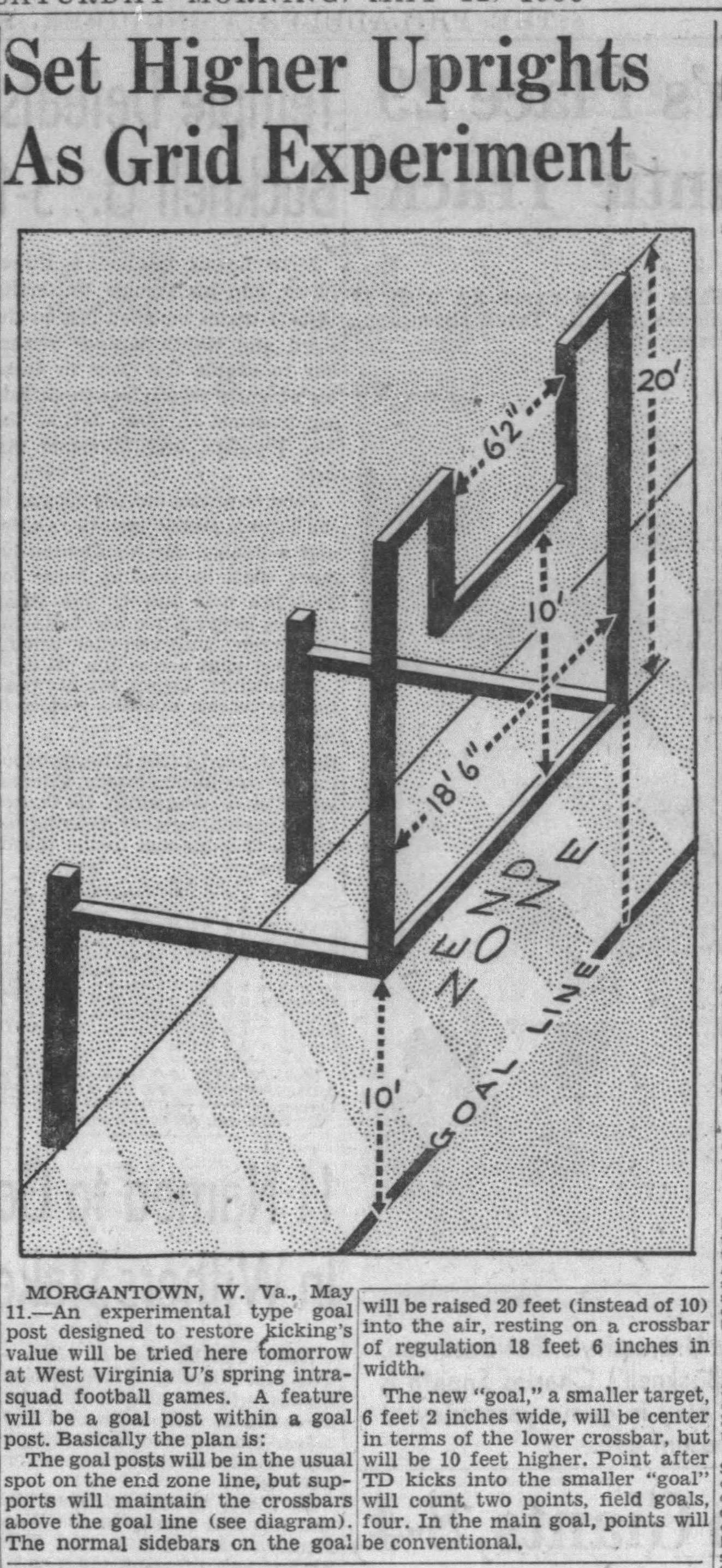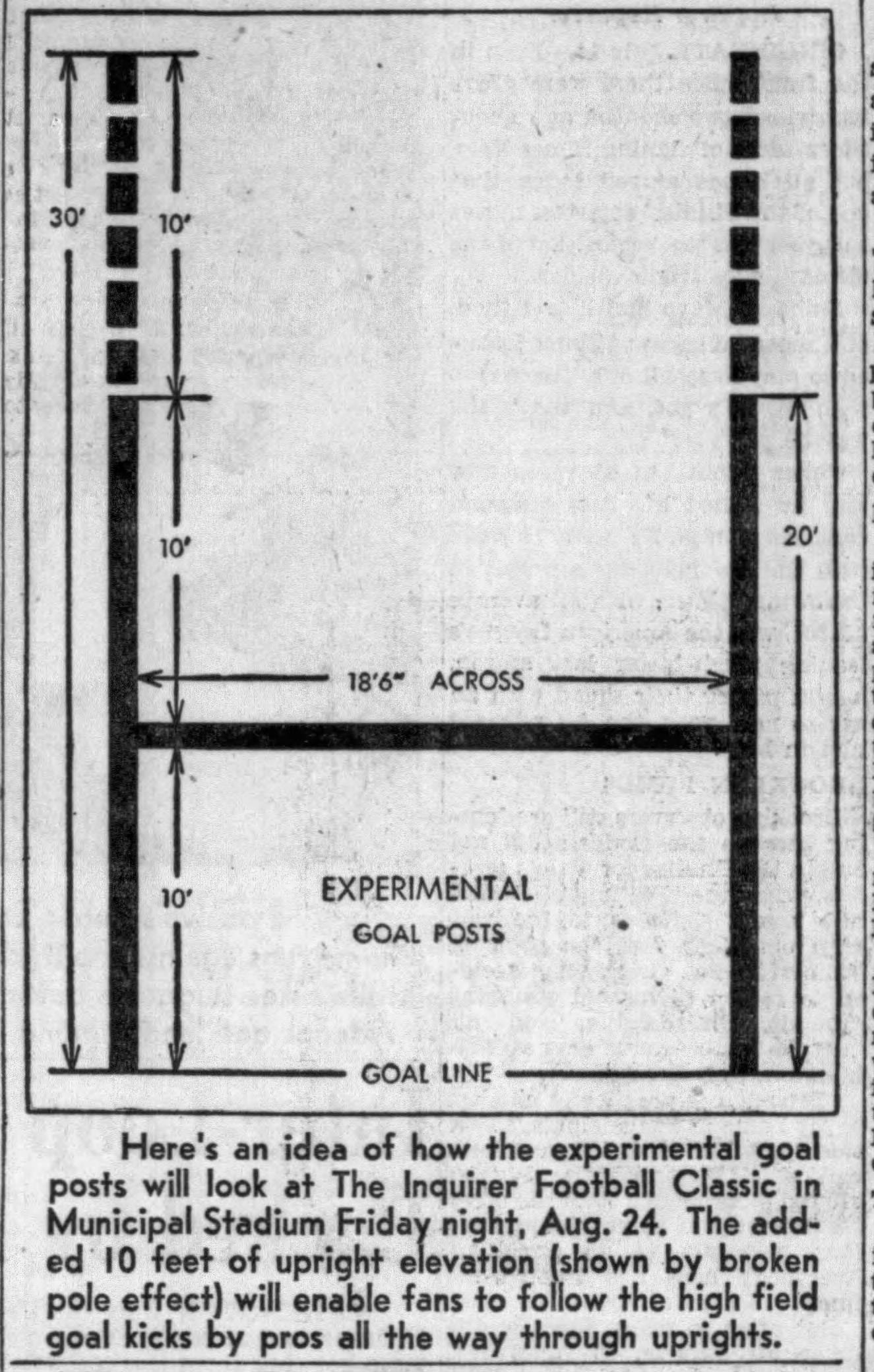Today's Tidbit... Setting New Standards For Goal Posts
A few days ago, I wrote about college football's adoption of the two-point conversion in 1958. In that article, I mentioned that college football increased the width of its goal posts in 1959 from 18 feet 6 inches to 24 feet 4 inches, which led to a reduced use of the two-point conversion. However, as often happens when researching a particular topic, the research on two-point conversions uncovered information about alternatives the rule makers considered other than widening the goal posts.
A previous article covered how high school, college, and pro football differed on the location and/or width of their goal posts from 1927 to 1991, leading to some places having two sets of goal posts on the field.
Before widening the goal posts and adding the two-point conversion, however, football considered alternative goal post designs seeking to increase scoring to reduce tie games and, as some said, put the foot back in football.
The most straightforward concept came during a Chicago Bears-Philadelphia Eagles exhibition game when they tested using goal posts with uprights 30 feet tall rather than 10. In this case, the taller upright idea focused on fans being better able to judge whether or not a kick was good. The idea did not come into effect until the last 1960s when a controversial ruling in a playoff game led to increasing the uprights' height one year earlier.
Earlier in 1956, one of the more bizarre goal post designs seen on a field came during West Virginia's spring game. Perhaps stealing an idea from Australian Rules Football which has two sets of posts and awards higher point values for kicks that sail between the inner posts rather than the outer posts. The Mountaineers applied the same concept and more.

The Mountaineer goal posts remained on the end line, with the crossbar extended over the goal line. The uprights stood 30 feet tall with a center goal six feet 2 inches wide, hanging 10 feet higher than the normal crossbar. Extra points kicked through the center goal counted two points, and field goals kicked through the center goal counted four points. Although it provided an interesting idea, the West Virginia test does not appear to have risen to the occasion.
When the college rule makers met in January 1958, they decided to test several alternative designs and sought schools willing the test the ideas in the coming months. Among the ideas they wanted to try were to:
Leave the goal posts in the current location but lower the crossbar
Widen the crossbar
Widen and lower the crossbar
Leave the goal posts in their current location but extend the crossbar five yards closer to the goal line
Interestingly, the last idea appears to have been the one preferred by the coaches on the advisory committee, with Georgia's coach, Wally Butts, suggesting it would be approved if someone could design a workable design that did not break the bank for the small colleges that would need to implement given rule change.
Although Oregon and Illinois agreed to conduct tests, only Oregon appears to have moved forward. Oregon built goal posts about 10 feet wider (the details vary depending on the report) and used a cantilevered structure to hang the crossbar three yards into the end zone. (Designs extending further into the end zone came with higher costs.) A graduating senior kicker attempted field goals from the 25 yard-line using the standard and experimental goal posts, with the latter increasing the made field-goal rate by 25 or 34 percent, depending on which report you believe.
In the end, the NCAA increased the goal post width to 23 feet 9 inches in 1959 and kept that standard until 1991, when they returned to the 18 feet 6-inch goal posts as extra point and field goal accuracy rates skyrocketed. The high schools did not return to the narrower version after the colleges did so, resulting in several more decades of inconsistency that remain today.
Football Archaeology is reader-supported. Click here to buy one of my books or otherwise support the site.





The original version of this post incorrectly stated that the high schools returned to the 18 feet 6 inches width. Had I checked the second article linked in this post, I would have confirmed the situation, but ...
I think the actual width in 1959 was 23 feet 4 inches. David Nelson's book mentioned that the longest 2x4 lumber was 24 feet long, so that's what was proposed. Then someone figured out that you have to fasten the crossbar to the uprights, which were often 4x4s, so you had to subtract 8 inches.